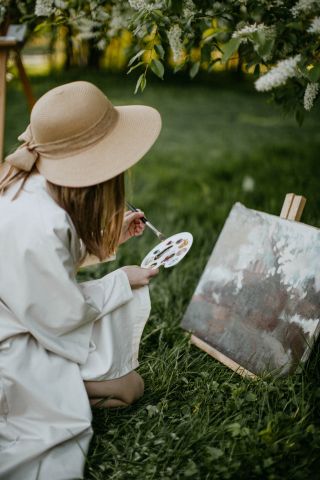Attention
To See Takes Time
How to engage the healing power of paying attention.
Posted August 18, 2023 Reviewed by Ray Parker
Key points
- Georgia O'Keeffe was one of the greatest artists of the 20th century.
- Her work has profound connections to the art of meditation.
- O'Keeffe brings attention to interpersonal relationships as well.

I recently saw an exhibition of Georgia O'Keeffe's work at the Museum of Modern Art (MOMA) in New York City; To See Takes Time has elevated my understanding of the creative process.
It also resonates with my interest in mindfulness and compassion. Furthermore, and unexpectedly, O’Keeffe’s wisdom and insights can enhance our interpersonal relationships.
Let me elaborate. O’Keeffe was a master of color and form, and one of the greatest artists of the 20th century. In an early exhibition of her work in 1944, she wrote about how simple things, like a flower or a sunset, are overlooked in our busy lives.
She pushed us to pay attention, writing:
I’ll paint what I see—what the flower is to me but I’ll paint it big and they will be surprised into taking time to look at it.
I don’t know if O’Keeffe was interested in Eastern philosophy, but artist Arthur Dow, O’Keeffe’s teacher in college, was very influenced by Zen philosophy. I think of the ancient Zen Master Hui-Neng’s teaching (638-713), “The meaning of life is to see.”
The Art of Meditation
Jon Kabat-Zinn, the creator of Mindfulness-Based Stress Reduction (MBSR), has helped thousands of people across the globe reduce stress, anxiety, and depression, and live happier and more peaceful lives.
I’ve been teaching MBSR for many years. Let me share an adaptation of one of the meditations that O’Keeffe would have appreciated. Hopefully, you will enjoy it as well.
The practice is short but profound. Put aside 3 to 5 minutes where you won’t be interrupted. Set a timer if you like.
Take Time To See
- Find something you want to look at. It can be anything—a flower, a leaf, a blade of grass, a stone.
- Choose something that is still.
- Start by getting comfortable, either sitting, standing, or lying down.
- Start looking at the object you have chosen.
- Your mind may wander, and you may get bored or restless. It’s OK. Keep looking.
- Notice the color, light, texture, and structure of your object.
- See with soft and loving eyes as you look.
- Take the time to really see. Utilize what Jon Kabat-Zinn calls your “exquisite intelligence.”
- Have fun with this. Imagine you are a bee finding this flower or a hummingbird.
- You may be tempted to look at other things. Don’t. Stay with your object.
- Let yourself get still and become quiet as you observe.
- When the time is up, you may want to thank your flower, leaf, or stone.
When I first tried this meditation practice, I looked at a petunia for 15 minutes. At some moments, it felt like an eternity. But as I slowed down, I noticed the intricacy of the flower.
I realized that I had never seen a petunia, just merely glanced at them. It was remarkable when I really stayed with it—beautiful and profound. And it was part of daily life. I had never taken the time to see it.
Jot down what came up for you.
- What did you notice?
- What did you feel?
- What were you thinking?
- Did your sense of time change?
- Did anything shift for you?
I have found that children and teens often enjoy this practice. You may want to shorten it if it seems more user-friendly.
When I reread the full quote from the exhibition, I realized that O’Keefe wasn’t just talking about looking at a flower. She included human relationships as well: “To see takes time, like to have a friend takes time.”
I see deep compassion in this quote, as well as powerful generosity. O’Keeffe is telling us that we don’t need to rush things and that we can see slowly and completely.
When I do this meditation, I become aware of light, the weather, sounds, winds, and smells. What would it be like to bring this practice to relationships? To develop the patience to hang in there with interpersonal relationships, with all kinds of weather and emotions? To see what someone is going through?
O’Keeffe is asking us to appreciate all that life has to offer, from noticing a flower or a sunset to the complexities of a friendship or an intimate relationship, and to give everything our full attention.
References
Friedman, Samantha (2023) Georgia O'Keeffe. To See Takes Time. New York: Museum of Modern Art.


